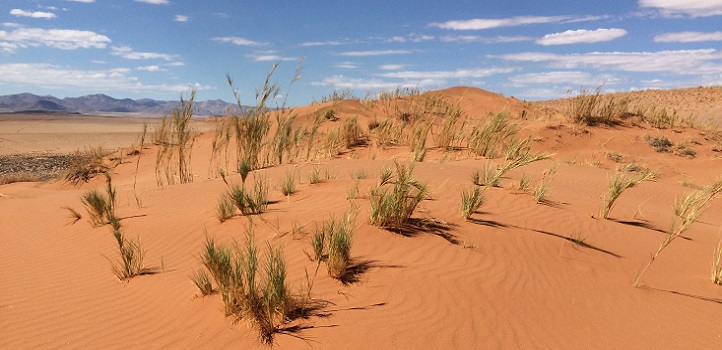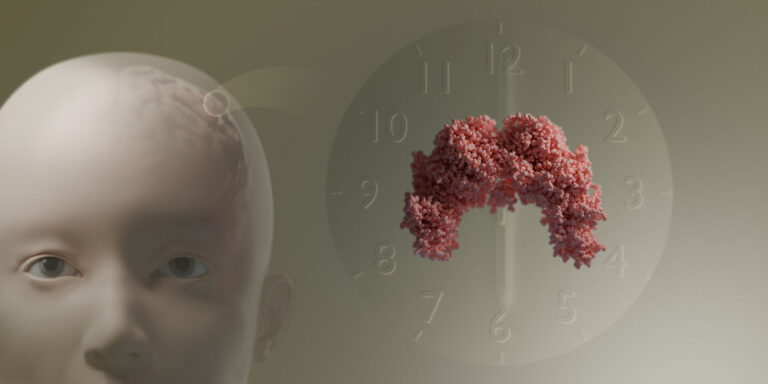Bioscience
Speargrass recruits sandy microbes for help
In the harsh sand of the Namib Desert, the sheaths of speargrass roots co-opt any growth-promoting bacteria they can find.


Daniele Daffonchio (left), Ramona Marasco (center) and Sadaf Umer (right) examine the structure of the rhizosheath-root system typical of desert speargrass.
© 2019 KAUST
Sticky, sandy sheaths surrounding the roots of three speargrass species growing in the Namib Desert recruit whatever growth-promoting bacteria are available in the surrounding sand. This is contrary to the more specialized root sheaths of plants growing in resource-rich soils, where different plant species recruit different types of bacteria.
The research led by KAUST has implications for predicting how well plants with root sheaths, including some food crops, will adapt to changing environmental conditions and stress.
The rhizosheath is an adaptive feature developed by some plant species that strengthens the contact between plant roots and the surrounding soil to improve nutrient and water uptake. Root hairs, fungal filaments and a sticky material formed by roots and microorganisms cause sand or soil granules to aggregate and form a sheath of soil encasing the entire root system. Desert speargrass species are among the types of plants to develop this adaptive trait and, until now, few studies have been conducted on this species’ rhizosheath-root system.
In resource-rich soils, where plants have abundant choice, different species are known to recruit specific types of bacteria to their roots. These growth-promoting bacteria facilitate the availability of nutrients, such as nitrogen, iron, and phosphorous, to the plants, and they can also confer disease resistance.
KAUST researchers are analyzing the microbial content of soil and identifying plant-growth-promoting bacteria in desert soils with the aim of applying these microbes to improve agricultural output.
© 2019 KAUST
KAUST bioscientist Daniele Daffonchio and colleagues predicted that a plant’s species would have a minimal impact on bacterial recruitment in the resource-poor sands of the Namib Desert and that different desert speargrass species would randomly recruit whatever bacteria available in the surrounding sands.

Ramona Marasco views the rhizosheath of speargrass through a stereomicroscope (Leica DFC295).
© 2019 KAUST
The team analyzed the microbial content of the soil and the roots of three different species of desert speargrass growing on the top, middle and bottom of a single dune in the Namib Desert. “It was important for us to analyze the plants growing in a restricted area to nullify the variability determined by the type of soil and the climate,” explains study co-author, Maria Mosqueira.
The team found that the rhizosheaths of all three species acted as a hot spot for relatively similar growth-promoting bacteria and fungi. Their finding indicates that the types of microbes present in the rhizosheath-root systems of the three kinds of speargrass were not driven by plant species, but rather by microbial availability in the surrounding sand.
“We are now trying to define which microbes are commonly associated with the rhizosheath and to understand their roles in favoring the fitness of their hosts,” says the study’s first author, Ramona Marasco. “The selection and isolation of such microorganisms can be a step toward evaluating their protective capacity on agricultural crops, such as wheat or barley,” she says.

The rhizosheath-root system was sampled using sterile scissors and tweezers and placed in 50-ml sterile tubes. Bulk sand samples were also collected.
© 2018 Ramona Marasco

A rhizosheath is the portion of soil that sticks to and encases certain plants’ entire root systems.
© 2018 Ramona Marasco

Microorganisms associated to the rhizosheath-root system of speargrasses.
Reproduced with permission from reference 1© 2018 Marasco et al.

Microorganisms associated to the rhizosheath-root system of speargrasses.
Reproduced with permission from reference 1© 2018 Marasco et al.
References
-
Marasco, R., Mosqueira, M. J., Fusi, M., Ramond, J-B., Merlino, G. Booth, J.M., Maggs-Kölling, G., Cowan, D., Daffonchio, D. Rhizosheath microbial community assembly of sympatric desert speargrasses is independent of the plant host. Microbiome 6, 215 (2018).| article
You might also like

Bioengineering
High value harvests from designer algae

Bioscience
Digging into the world of plant-growth-promoting microbes

Bioengineering
Stray DNA fragments challenge CRISPR precision

Bioscience
Unique microbiome discovered in mountain streams

Bioscience
How a multitasking protein keeps the body’s clock in sync

Bioscience
The theory of everything that wasn’t

Bioscience
Mangrove microbes to munch on plastic

Bioscience




